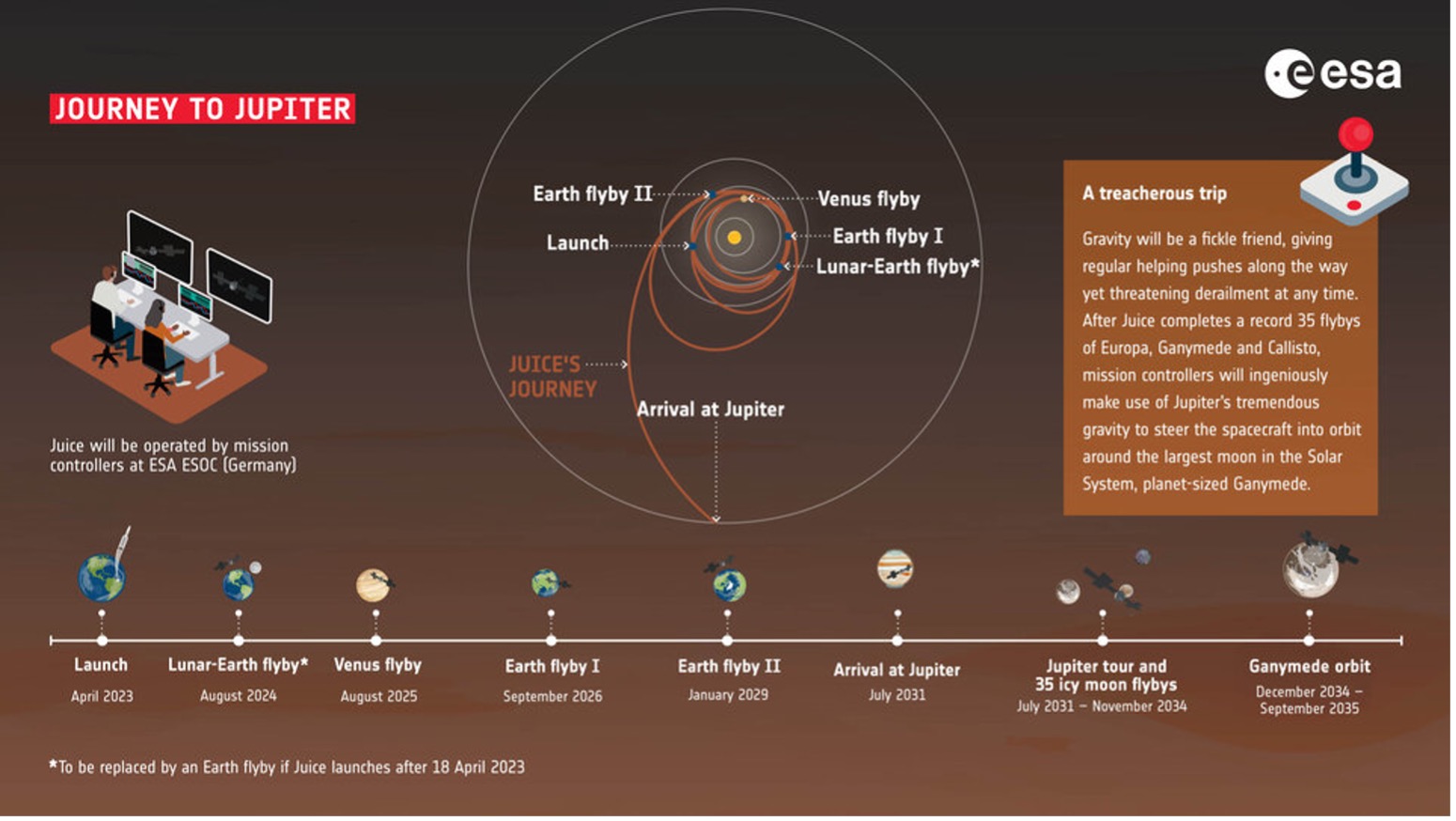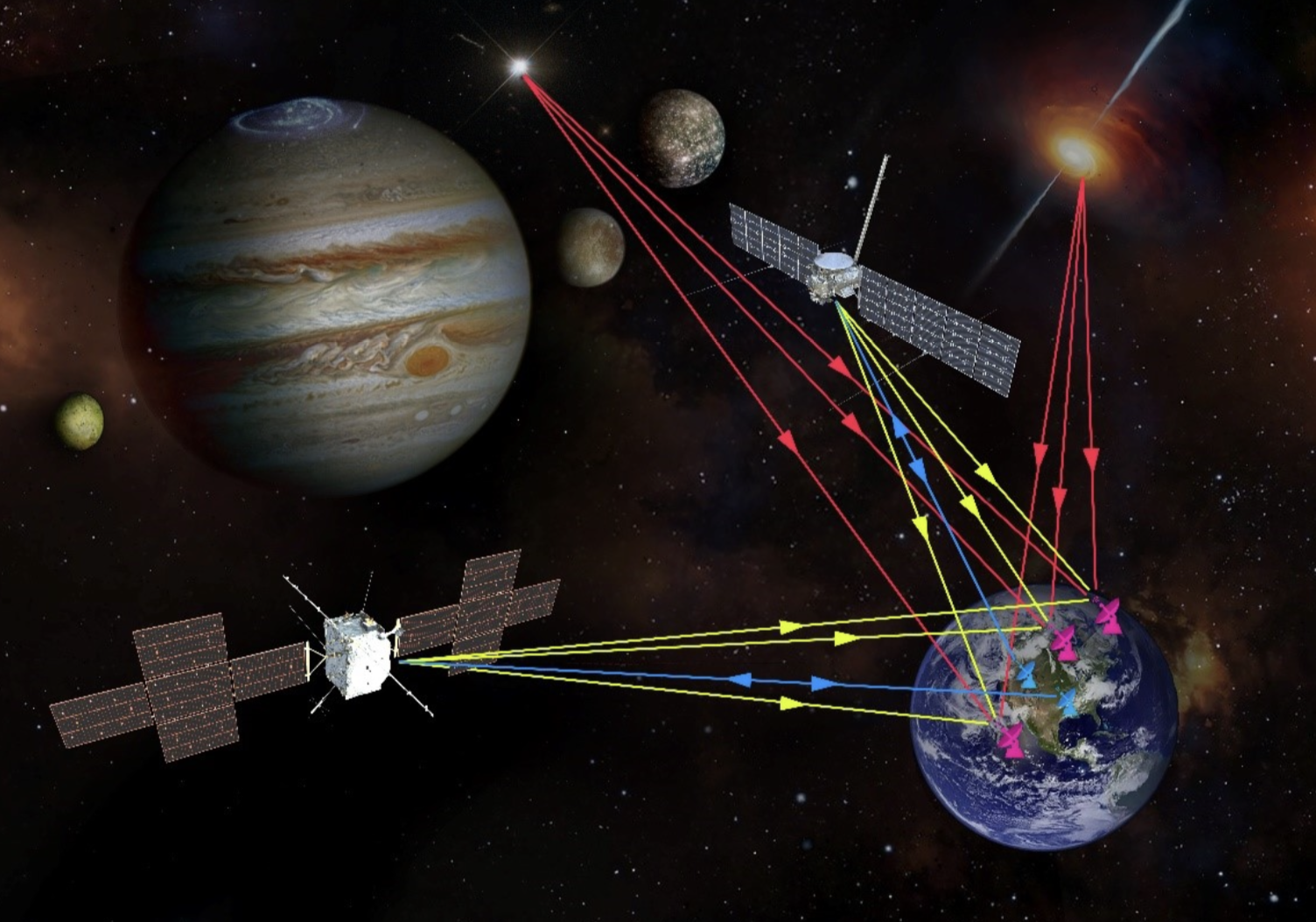
Navigating the Cosmos: Mastering PRIDE-JUICE VLBI Operations
Vidhya Pallichadath
Jupiter Icy Moons Explorer (JUICE) was launched on April 14, 2023, on an Ariane 5 rocket from the European Spaceport in Kourou, French Guiana. JUICE is the first large-class science mission of the European Space Agency's (ESA) Cosmic Vision 2015–2025 program. As JUICE continues its orbit around the gas giant, the Planetary Radio Interferometry and Doppler Experiment (PRIDE) project, led by JIVE and Delft University of Technology as PI and co-PI organisations, respectively, stands at the forefront of scientific exploration, employing Very Long Baseline Interferometry (VLBI) techniques to unravel the mysteries of Jupiter's moons. JUICE's journey is depicted in figure 1. Ultimately, JUICE will arrive in the Jovian system in July 2031. During its journey, JUICE will perform three flybys of Earth: one involving the Earth-Moon system in August 2024, another encounter with Earth in September 2026, and a third with Earth in January 2029. The mission will cruise toward Jupiter for about eight years. JUICE will begin scientific investigations six months prior to entering Jupiter's orbit. Subsequently, it will spend several months orbiting Jupiter, executing 35 flybys of its icy moons Europa, Ganymede, and Callisto, culminating in an orbital exploration of Ganymede.

PRIDE aims to enhance our understanding of Jupiter's system and its icy moons through VLBI and precise Doppler measurements. The main measurables of PRIDE, the JUICE spacecraft celestial coordinates (VLBI) and radial velocity (Doppler) will contribute into obtaining crucially important for the science program of the mission ephemerides of the spacecraft and natural bodies of the Jovian system. The scheduling for the PRIDE observations for the JUICE mission involves intricate planning and coordination. For both, interferometric and Doppler observations, PRIDE relies heavily on VLBI methods, instrumentations and software. Numerous factors need to be taken into account prior to conducting a PRIDE observation, such as the spacecraft transmission window, opportunities phase referencing with nearby calibrators (sometimes – in-beam calibrators), and the availability of Earth-based radio telescopes ground stations. These considerations significantly influence the planning of an observation. Accurate determination of JUICE's state vector is crucial for extracting meaningful scientific data. To achieve this, PRIDE utilizes phase-referencing technique by observing background natural celestial radio sources, mostly – quasars with best known astrometric coordinates. By observing these celestial beacons intermittently with JUICE, PRIDE will provide inputs into estimates of the ephemerides of JUICE spacecraft and celestial bodies in the Jovian system, thus enhancing our understanding of the planet's dynamic environment, its formation and evolution.

The accuracy of PRIDE data collected in observations of JUICE are heavily dependent on the “astrometric quality” and proximity of the selected phase reference sources. In instances where suitable phase-reference sources are not readily available near the JUICE’s celestial position during specific time windows, a focused observational campaign will be arranged to expand the roster of suitable reference sources within the designated sky area. However, this campaign must be conducted independently of and before the spacecraft's VLBI observations. Before the JUICE Venus flyby scheduled for 2025, preparatory VLBI planning will take place to characterize calibrator sources and identify potentially suitable in-beam phase-reference calibrators. Some upcoming tasks include enhancing the reference catalogue, conducting cruise phase observations during communication/downlink sessions and/or Delta DOR (Differential One-way Range) sessions outside of flybys, and making observations close to the Venus flyby. Additionally, plans involve conducting training sessions for acquiring VLBI data to improve Solar System ephemerides, studying occultation profiles at Venus and/or the Moon (during Lunar flyby), and acquiring training datasets for operations in the Jovian system in regular nodding phase-referencing mode, in-beam calibrator mode, and in-beam with second spacecraft (the NASA’s Europa Clipper mission) mode. As JUICE progresses through its mission, PRIDE-JUICE operations will undergo abovementioned tests to validate and refine observational and data processing techniques aiming to extract valuable scientific insights from VLBI and Doppler observations.
Contact:
Vidhya Pallichadath
Lead Engineer, PRIDE-JUICE, TU Delft, the Netherlands
Email: v.pallichadath@tudelft.nl